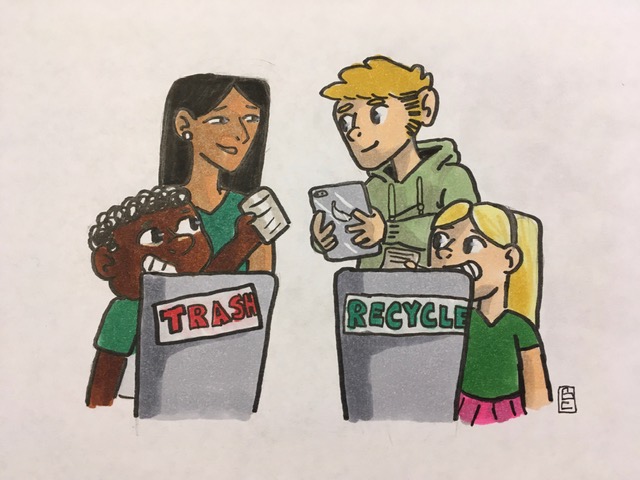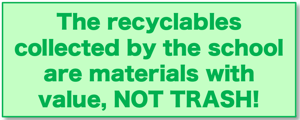
Phase Six: Track, Adjust and Sustain
When you design your recycling program, make sure you have a plan to track your progress. Measure how the total trash and recycling volumes/weights are changing. Make observations about contamination and problematic areas.
Regular monitoring of the metrics of your program (number of pickups, weights of recyclables, savings, etc.) will help assure you that the program is maintaining a high level of compliance. Yearly figures on how many pounds or tons of recyclable material has been collected should be obtained from your recycling hauler or recycling facility. If your recyclables are not picked up through your municipal contract or by your municipality, it is important that these metrics are provided to your municipal recycling coordinator for collection and subsequent reporting.
Beyond metrics, you will need to have periodic monitoring of the physical elements of your school’s recycling program. Over time, containers can be moved or taken, labels can become illegible, and new employees or students may not be following recycling guidelines. Therefore, a quarterly or semi-annual audit of your program is both wise and essential. Here are some elements that this audit can include:
Recycling Monitoring Checklist
Containers
- Labels present and legible?
- Are they in all of the proper locations?
- Are trash containers right next to recycling containers?
- No plastic liner in recycling containers? (except maybe for cans and bottles)
- Sufficient number?
- Sufficient size for volume being generated?
Compliance
- Are the materials being sorted properly – is there trash in the recyclables or are there recyclables in the trash?
- Is container type or location hindering sorting?
- Are there common violations indicating poor communication of requirements?
Placement
Are containers present…
- In copier rooms?
- In classrooms?
- In centralized collection areas?
- In cafeteria?
Also, the ability for materials to be collected and recycled changes over time. Your school may purchase milk in cartons at one time and later purchase milk in plastic bottles. When materials change, you need to determine whether they are recyclable. Recycling markets change as well, which means your hauler may someday be able to accept, for recycling purposes, materials that for now are considered to be trash. Keep in touch and learn what new or additional services the hauler can provide. Contact ANJR, or your municipal recycling coordinator or county recycling coordinator for assistance.
 Unless the recyclables are prepared properly and kept free of contamination, the program will fail. The school must treat the recyclables as materials that have value, not just as another form of trash. The key to quality control is regular monitoring of recyclables. In many schools, students enjoy serving as monitors. It is critical for all adults and students to be aware of which materials are acceptable in the school’s recycling containers and which belong in the trash containers. Monitors should screen the recycling containers before collection day and either remove all contaminants or leave the recyclables behind with a notice stating why the container is unacceptable. The monitors also should notify the Central Coordinator about continuing problems.
Unless the recyclables are prepared properly and kept free of contamination, the program will fail. The school must treat the recyclables as materials that have value, not just as another form of trash. The key to quality control is regular monitoring of recyclables. In many schools, students enjoy serving as monitors. It is critical for all adults and students to be aware of which materials are acceptable in the school’s recycling containers and which belong in the trash containers. Monitors should screen the recycling containers before collection day and either remove all contaminants or leave the recyclables behind with a notice stating why the container is unacceptable. The monitors also should notify the Central Coordinator about continuing problems.
A “Materials Not Acceptable” card can be created by the school, to be left behind whenever unacceptable materials are found in a classroom, office, teachers’ lounge or elsewhere. On the other hand, don’t underestimate the power of positive feedback – develop a thank-you card to recognize good habits, or list good recyclers on the school website.
When contamination occurs in materials generated in the cafeterias, the food service managers and their staff should be notified about being more careful, and students should have the recycling message reinforced through loudspeaker announcements and onsite monitors.
The team leader should visit each school periodically, not only to answer questions and to provide progress reports, but also to spot-check for contaminants. Even the most carefully planned and implemented program can fall apart if quality control is not maintained.
Meetings with the superintendent should be scheduled as needed with the Central Coordinator and buildings and grounds manager, to discuss the program’s progress. Successes and failures should be discussed, and solutions determined. Meetings with the business administrator should be scheduled as needed, to discuss contractual issues with the hauler, and to review data from initial and routine waste audits to understand the management of materials generated in the school. Prior to the contract’s expiration, the business administrator will need to develop new bid specifications, taking into account the expertise of the recycling team. She/he may also be the representative who provides summaries of volumes or tons of materials recycled to the municipal recycling coordinator for use in the municipality’s tonnage report. This is the time to “right-size” dumpsters, explained further below.
As you did in Phase 1 when you were examining your trash contract, you should continue monitoring your trash and recycling dumpsters to see if they are adequately sized. Your recycling program should result in less trash and more recyclable material, so you should be reassessing the size, quantity, and/or frequency of collection for both recyclables and trash.
Use your trash and recycling tracking sheets to assess whether your trash and recycling dumpsters are meeting your program needs. Consider the following questions when reviewing your hauling services:
- How often are the trash dumpsters serviced?
- Are the dumpsters full each time they are serviced? If not, ask your hauler to reduce the frequency of pickup or reduce the size of the dumpster(s). Many schools have excess trash dumpster capacity and pay more for trash removal than they need to.
- How often are the recycling carts or dumpsters serviced?
- Are recycling carts full each time they are serviced?
- Are they ever full a day or two (or more) before they are serviced? If your recycling carts or dumpsters seem to fill up quickly, ask your hauler to increase the size or number of recycling carts or dumpsters, or ask the hauler to increase the frequency of pickup. Many schools fill their recycling containers too quickly, thus leaving no room for the recyclables that are collected. Cardboard boxes should be broken down so that they take up less room in the dumpster.
Adjusting the future contracts (preparing for the contract procurement)
Meet with the school’s contract representative to address ideas for changing the school’s trash collection. Be sure to have the trash and recycling tracking sheet with you. After meeting with the school’s contract representative, meet with your trash and recycling hauler to request the service changes and receive a price estimate. Note that some services may not be able to be changed in the middle of the contract. You can check with your contract representative and hauler. If your hauler can make the requested service changes, continue to track the trash and recycling to ensure that the changes to the collection are meeting the needs of your school. If your contract does not allow for changes, keep track of your collection needs so that they can be addressed in the next contract.
To ensure that a successful program continues, the recycling team needs to incorporate recycling into the daily school culture.
- School business officials should track trash and recycling costs and volumes regularly. Include recycling duties in job descriptions for the procurement or business officials, buildings and grounds and food service managers and personnel and include recycling as a responsibility of all students in the student handbook.
- Budget for maintenance costs, such as container replacements and staff time.
- Include recycling guidelines in the school’s energy policy and/or general school policy.
- Include recycling guidelines in new student and staff orientation and training.
Consider issuing a year-end reminder to all students and staff before summer vacation begins. This will help address cleanout of desks, lockers, labs, etc., and ensure that recyclable material is not disposed of as trash. Here is a sample end-of-year recycling announcement/notice.
